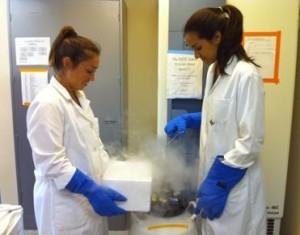Scientists Create Coral Sperm Bank in Hawaii
/https://tf-cmsv2-smithsonianmag-media.s3.amazonaws.com/filer/20110520110618image004-300x224.jpg)
Last year, Smithsonian magazine reporter Megan Gambino traveled to Panama to witness a rare event—the spawning of a coral reef. This healthy reef lives off the coast of Panama. But the situation for much of the world's coral reefs is dire. Some scientists predict that if change doesn't come soon, corals will cease to exist as we know them within the next 40 years.
One potential solution is the creation of coral sperm banks. This allows scientists to freeze the sperm and embryos of many different coral species, so that they will be able to maintain species that may go extinct in the wild. The Smithsonian recently partnered with scientists at the University of Hawaii at Manoa to create the very first frozen coral repository from Hawaii. According to the Hawaii Coral Reef Initiative, the island state is home to 410,000 acres of coral reef, which makes up almost 85 percent of all coral reef ecosystems in the United States.
"Because frozen banked cells are viable, the frozen material can be thawed one, 50 or, in theory, even 1,000 years from now to restore a species or population," said researcher Mary Hagedorn of the Smithsonian Conservation Biology Institute in a report. Some of the frozen sperm samples from the repository have already been used to fertilize coral eggs.

Coral reef biologist Nancy Knowlton, Smithsonian's Sant Chair for Marine Science, says poor water quality, overfishing and CO2 emissions pose the greatest threat to the world's coral reefs. The earth's oceans have absorbed approximately 525 billion tons of CO2 from the atmosphere. This CO2 makes the oceans more acidic, which in turn impairs corals' ability to build their calcified structures. Global temperature increases can also cause "coral bleaching," where coral loses its color and then starves to death because the microscopic algae it feeds on cannot survive water temperatures even two degrees Fahrenheit above seasonal averages.
So far, the new coral sperm bank contains embryonic cells from the neon-colored mushroom coral (Fungia scutaria, above) and rice coral (Montipora capitata), but scientists plan to harvest many more different species that are important to Hawaiian reefs.
/https://tf-cmsv2-smithsonianmag-media.s3.amazonaws.com/accounts/headshot/jess-righthand-240.jpg)
/https://tf-cmsv2-smithsonianmag-media.s3.amazonaws.com/accounts/headshot/jess-righthand-240.jpg)